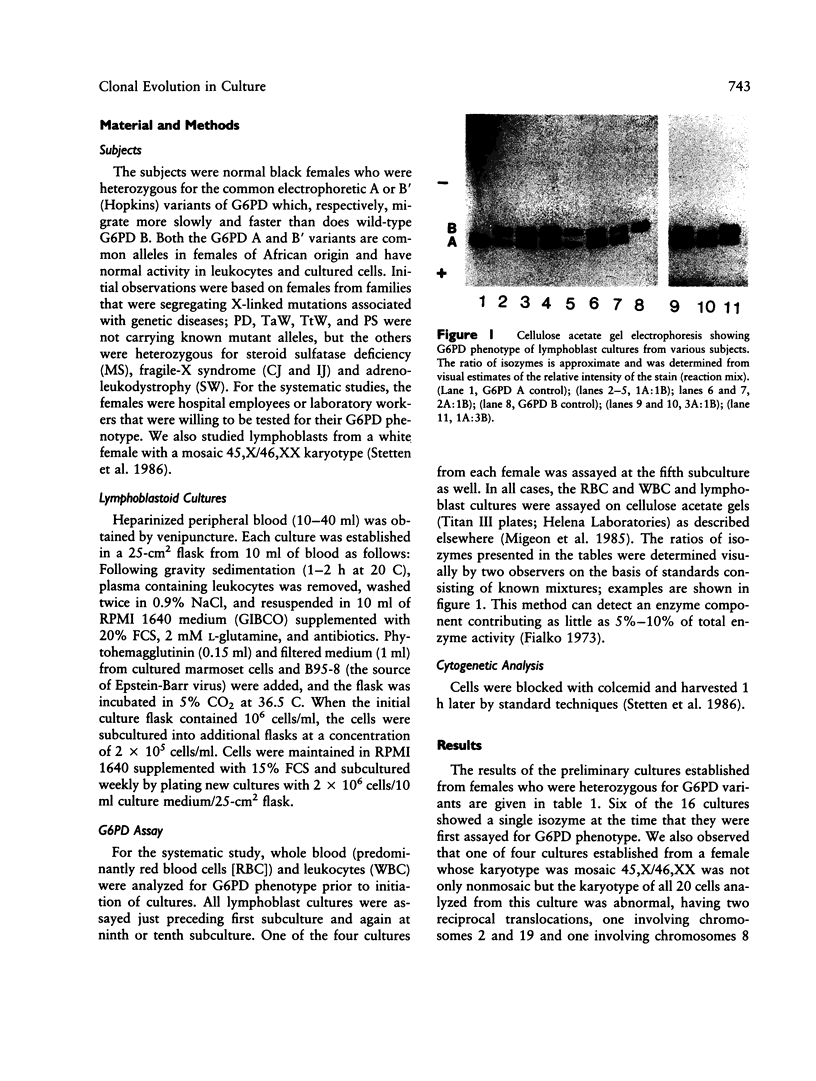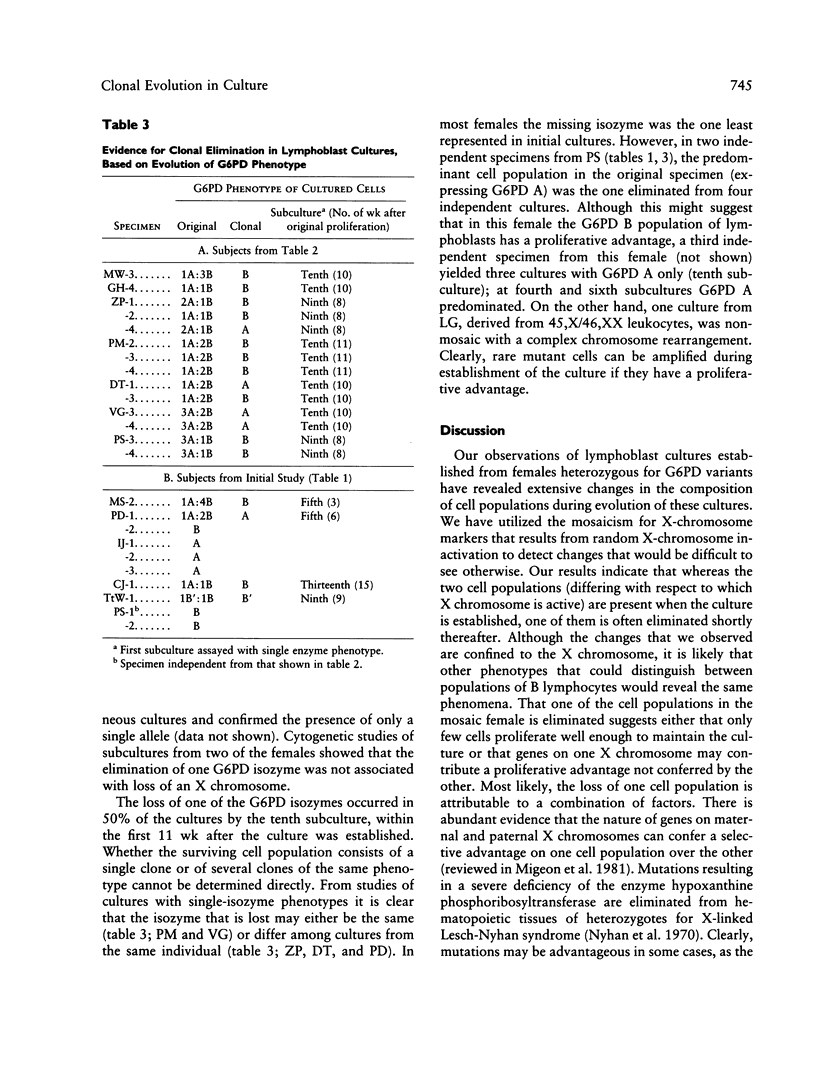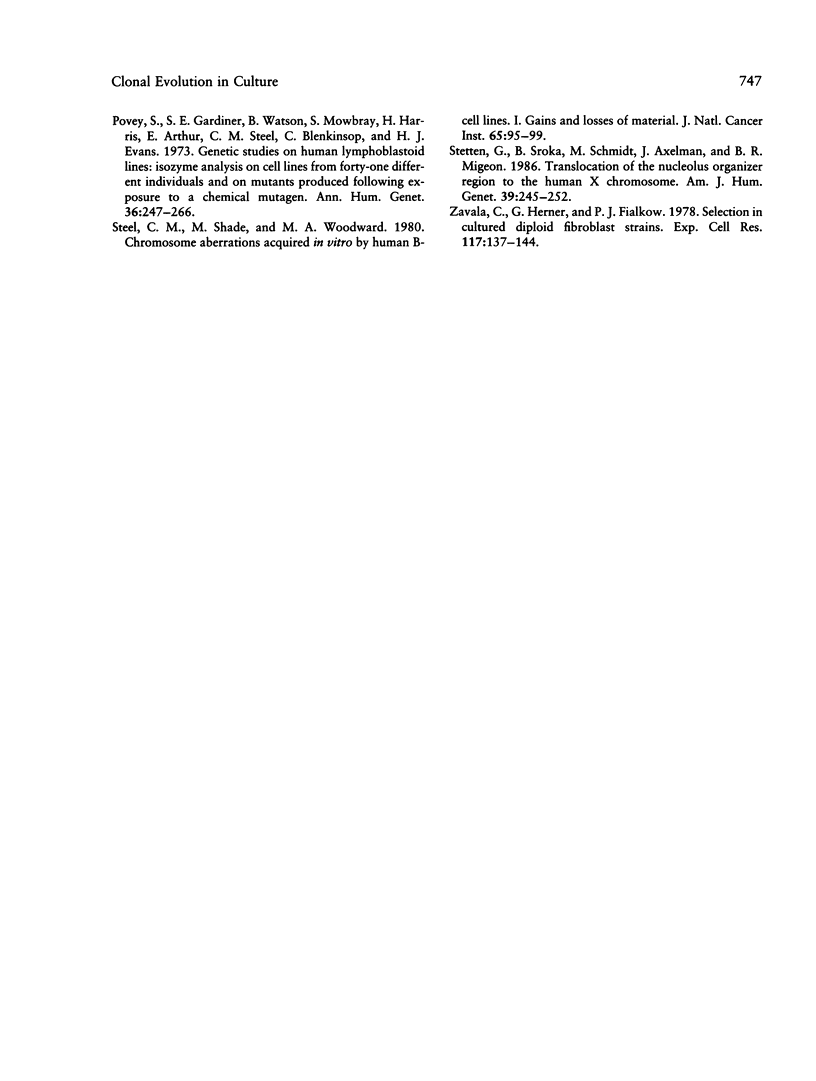Abstract
We established lymphoblast cultures from normal females heterozygous for electrophoretic variants of glucose-6-phosphate dehydrogenase (G6PD), and the X-linked markers have permitted us to look at evolution of these cell populations in culture. The established cultures were phenotypically heterozygous at onset, having both of the mosaic cell populations resulting from X chromosome inactivation. However, by the tenth subculture, the population of cells no longer reflected the heterozygous genotype in 50% of the cultures, as only a single G6PD isozyme was expressed. The ultimate cell composition seems to be influenced by the initial composition, by the nature of alleles at heterozygous X-linked loci that may provide a growth advantage (or disadvantage), as well as by stochastic events. Our results show that lymphoblast cultures may not reflect the X-linked phenotype of the cells from which they were derived. The fate of such cultures seems to be evolution toward clonal cell populations.
Full text
PDF





Images in this article
Selected References
These references are in PubMed. This may not be the complete list of references from this article.
- Abruzzo M. A., Hunt P. A., Mayer M., Jacobs P. A., Wang J. C., Erbe R. W. Cytogenetic analysis of lymphoblastoid cell lines. Cytogenet Cell Genet. 1986;42(3):169–173. doi: 10.1159/000132271. [DOI] [PubMed] [Google Scholar]
- DAVIDSON R. G., NITOWSKY H. M., CHILDS B. DEMONSTRATION OF TWO POPULATIONS OF CELLS IN THE HUMAN FEMALE HETEROZYGOUS FOR GLUCOSE-6-PHOSPHATE DEHYDROGENASE VARIANTS. Proc Natl Acad Sci U S A. 1963 Sep;50:481–485. doi: 10.1073/pnas.50.3.481. [DOI] [PMC free article] [PubMed] [Google Scholar]
- Fialkow P. J. Primordial cell pool size and lineage relationships of five human cell types. Ann Hum Genet. 1973 Jul;37(1):39–48. doi: 10.1111/j.1469-1809.1973.tb01813.x. [DOI] [PubMed] [Google Scholar]
- Lyon M. F. X-chromosome inactivation and developmental patterns in mammals. Biol Rev Camb Philos Soc. 1972 Jan;47(1):1–35. doi: 10.1111/j.1469-185x.1972.tb00969.x. [DOI] [PubMed] [Google Scholar]
- Migeon B. R., Moser H. W., Moser A. B., Axelman J., Sillence D., Norum R. A. Adrenoleukodystrophy: evidence for X linkage, inactivation, and selection favoring the mutant allele in heterozygous cells. Proc Natl Acad Sci U S A. 1981 Aug;78(8):5066–5070. doi: 10.1073/pnas.78.8.5066. [DOI] [PMC free article] [PubMed] [Google Scholar]
- Migeon B. R., Wolf S. F., Axelman J., Kaslow D. C., Schmidt M. Incomplete X chromosome dosage compensation in chorionic villi of human placenta. Proc Natl Acad Sci U S A. 1985 May;82(10):3390–3394. doi: 10.1073/pnas.82.10.3390. [DOI] [PMC free article] [PubMed] [Google Scholar]
- Moore G. E., Gerner R. E., Franklin H. A. Culture of normal human leukocytes. JAMA. 1967 Feb 20;199(8):519–524. [PubMed] [Google Scholar]
- Nyhan W. L., Bakay B., Connor J. D., Marks J. F., Keele D. K. Hemizygous expression of glucose-6-phosphate dehydrogenase in erythrocytes of heterozygotes for the Lesch-Nyhan syndrome. Proc Natl Acad Sci U S A. 1970 Jan;65(1):214–218. doi: 10.1073/pnas.65.1.214. [DOI] [PMC free article] [PubMed] [Google Scholar]
- Povey S., Gardiner S. E., Watson B., Mowbray S., Harris H., Arthur E., Steel C. M., Blenkinsop C., Evans H. J. Genetic studies on human lymphoblastoid lines: isozyme analysis on cell lines from forty-one different individuals and on mutants produced following exposure to a chemical mutagen. Ann Hum Genet. 1973 Jan;36(3):247–266. doi: 10.1111/j.1469-1809.1973.tb00588.x. [DOI] [PubMed] [Google Scholar]
- Steel C. M., Shade M., Woodward M. A. Chromosome aberrations acquired in vitro by human B-cell lines. I. Gains and losses of material. J Natl Cancer Inst. 1980 Jul;65(1):95–99. [PubMed] [Google Scholar]
- Stetten G., Sroka B., Schmidt M., Axelman J., Migeon B. R. Translocation of the nucleolus organizer region to the human X chromosome. Am J Hum Genet. 1986 Aug;39(2):245–252. [PMC free article] [PubMed] [Google Scholar]
- Zavala C., Herner G., Fialkow P. J. Evidence for selection in cultured diploid fibroblast strains. Exp Cell Res. 1978 Nov;117(1):137–144. doi: 10.1016/0014-4827(78)90436-6. [DOI] [PubMed] [Google Scholar]



